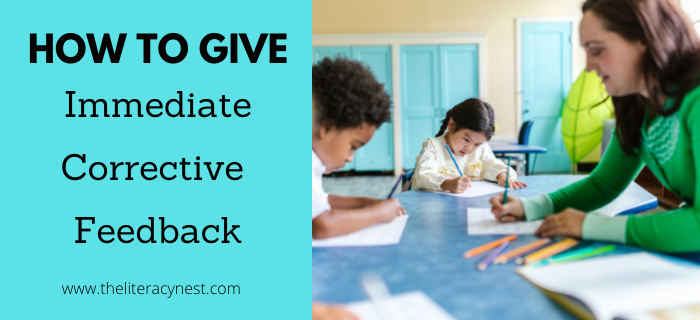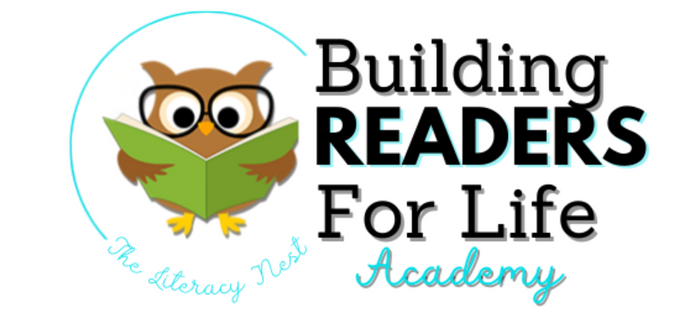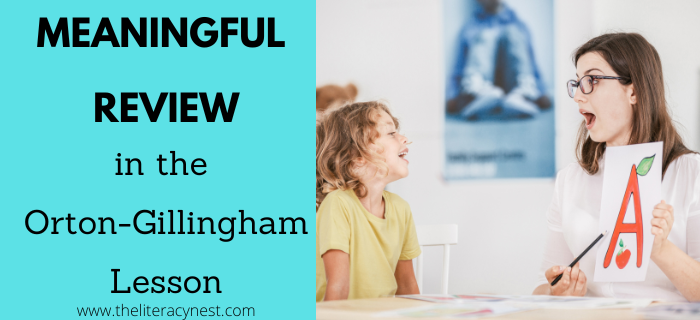The Importance of Giving Corrective Feedback

When seeking tips for giving corrective feedback, think of the process as a form of on-the-spot, contingent teaching. You, the teacher asks questions, and assess where your child has erred. Then you apply just the right quantity of explicit instruction.
This ability to respond to your student needs on the fly is one of the things that makes highly skilled Orton-Gillingham teachers stand out.
Why is Immediate Corrective Feedback Important?
Immediate corrective feedback differs in a couple of ways. One of the benefits of working with students 1:1 is the ability to catch and correct errors as they are happening. It is critical in the Orton-Gillingham lesson because we can prevent students from practicing and habituating flawed processes. We can scaffold them toward a correct and successful outcome. This may sometimes come in the form of error correction. It can be done thoughtfully and presented in a way that probes your students to self-correct.
You can explore how error correction looks in Tips for Error Correction.
What immediate corrective feedback does and does NOT do:
The idea of giving immediate corrective feedback may bring to mind a soul-crushing image of your student. You might think it sounds like someone feeling discouraged when hearing “NO! WRONG!”. This is certainly not the goal and not a productive way for corrective feedback to be given.
Nor is the goal just to tell the student the correct answer in most circumstances. Rather, it is used to encourage the use of metacognition, guide student decision-making, lead them along the path toward mastery and encourage independence. This process supports the gradual release of responsibility, a crucial part of explicit teaching.
Be sure to check out this episode of the Together in Literacy podcast for a deeper look at the gradual release of responsibility.
Seeing how a student responds also informs our instruction on the concept needing review for the next lesson allowing us to prepare just the right amount of support and practice.
Helpful tips to keep in mind when offering corrective feedback:
1. Structure your language in the form of questions.
These questions should probe your student’s thinking appropriately. For example: “Why did you choose to double the s when you wrote miss on your paper?” “What vowel sound do you hear in the middle of spine? I notice that the word you wrote has 1 vowel and ends with a consonant. What type of syllable is that? What kind of vowel sound do you usually hear in closed syllables?” “Let’s look at this word. Spell it out loud for me. If I spell rabbit as r-a-b-i-t, then how will I have to read this word? What should you fix?”
2. Choose appropriate times for feedback that won’t interrupt the flow of the lesson.
This is a balancing act. You don’t want to allow a student to make a mistake repeatedly by waiting to correct it, but you also don’t want to stop them midsentence repeatedly. It is important for students to learn to self-monitor as well. Pick your moment strategically with something that moves the child’s learning forward.
3. Use an economy of words.
Students with dyslexia and students with ADHD may have difficulty processing language. Be concise, explicit, and direct. Corrective feedback isn’t a lecture or monologue.
4. Try not to use more support than your student needs.
For example, with a spelling rule that you are confident your student knows well, perhaps the only direction needed is to say, “Something is not quite right, can you find the problem?” This promotes not only metacognitive thinking but independent self-monitoring. But don’t play 20 questions. If the student can’t find the error independently, increase the level of support immediately by drawing their attention to the right place.
5. Take advantage of opportunities for students to immediately practice a strategy or rule you just helped them with.
For example, if a student is doing spelling dictation and forgets to employ the doubling rule on the word spinning, after you have questioned and guided the way through that word, you can reinforce this strategic thinking by asking students to isolate the base word in their next spelling word, spotted. Ask them if they need to double the t and then ask why? This allows them to utilize the rule and rather than just guessing what they think you want to hear; they can explain their thinking to demonstrate their understanding.
For a structured approach to teaching spelling, check out this systematic phonics and Orton-Gillingham bundle!
6. Ask metacognitive questions when students are right as well.
This helps to avoid a pattern where students just respond to any question by changing their answers and helps them feel confident and flexible with what they know.
Download our printable checklist for giving corrective feedback!
A final tip to remember…
Be aware that the corrective feedback and the student response to it offer insight into what needs to be reviewed in upcoming lessons. Patterns of errors may warrant more direct instruction on that topic. A lack of fluency with a particular spelling rule or pattern may suggest some built-in practice for the next few lessons.
Your students’ errors are highly informative. Taking A Closer Look At Spelling Errors takes a closer look at what errors can tell you and what the next steps should be when lesson planning.

Are you looking for professional development that will help you become a more effective structured literacy educator? The Literacy Nest has a membership for that…
Building Readers for Life Academy is a monthly membership program that empowers educators AND families by diving into structured literacy and strategies for ALL learners. With BRFL Academy, you’ll learn what it takes to help EVERY student become a reader for life.





